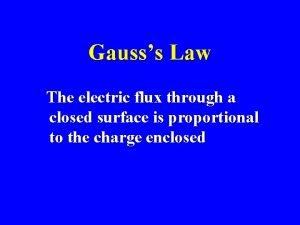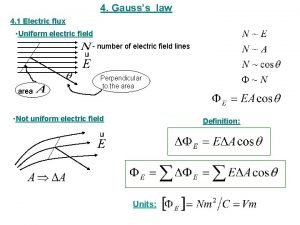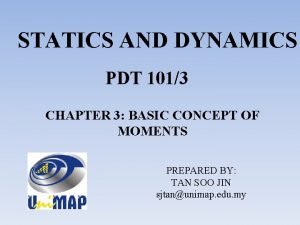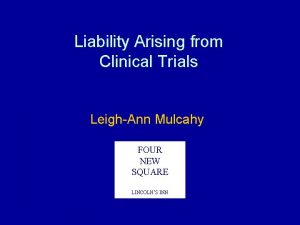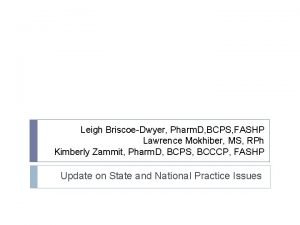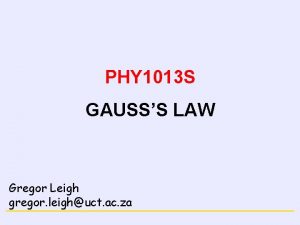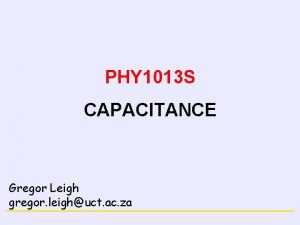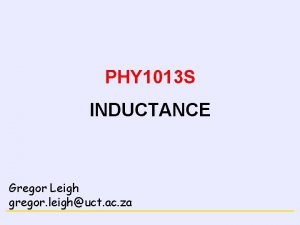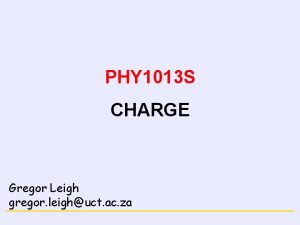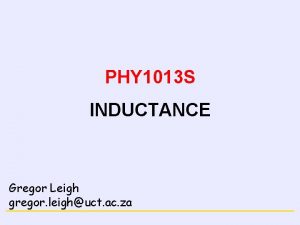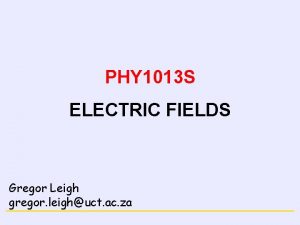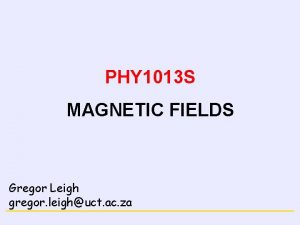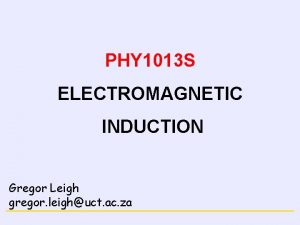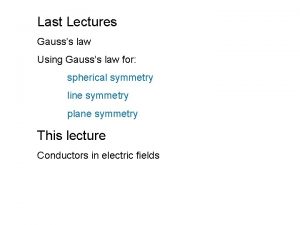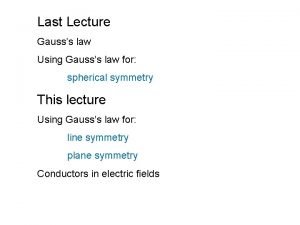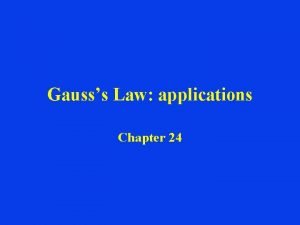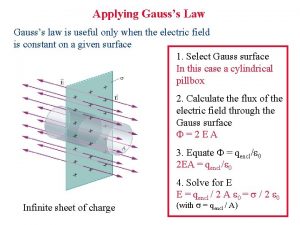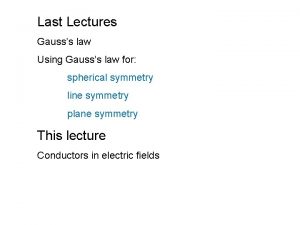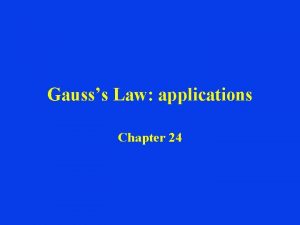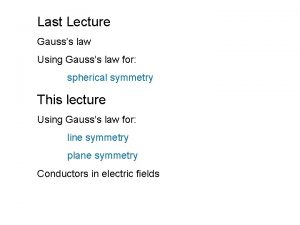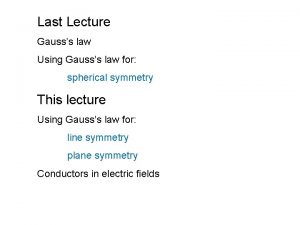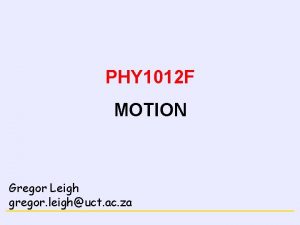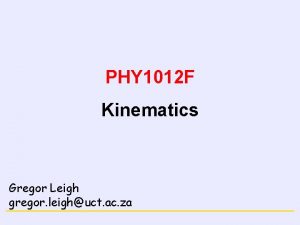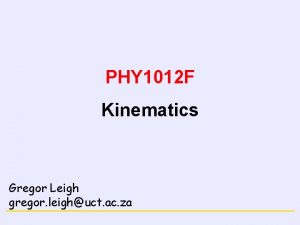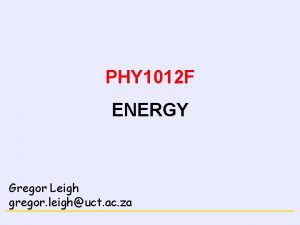ELECTRICITY PHY 1013 S GAUSSS LAW Gregor Leigh


























- Slides: 26

ELECTRICITY PHY 1013 S GAUSS’S LAW Gregor Leigh gregor. leigh@uct. ac. za

PHY 1013 S ELECTRICITY GAUSS’S LAW Learning outcomes: At the end of this chapter you should be able to… Calculate the electric flux through a surface. Use Gauss’s Law to calculate the electric field due to symmetric charge distributions. Use Gauss’s Law to determine the charge distribution on hollow conductors in electric fields. 2

PHY 1013 S ELECTRICITY GAUSS’S LAW FLUX is the unit vector normal to a surface. is the surface’s area vector. The amount of flow, , through the surface depends on: the magnitude of the velocity, v; the area of the surface, A; the angle between and. ( is a maximum when = 0°; a minimum for = 90°. ) Hence: = v. Acos or just: Replacing the velocity vector with the electric field vector , we get: 3

PHY 1013 S ELECTRICITY GAUSS’S LAW FLUX For a surface made up of small elements, each A, the total flux is For a closed (Gaussian) surface, in the limit A 0, [N m 2/C] The electric flux through a Gaussian surface is proportional to the net number of electric field lines passing through that surface. 4

PHY 1013 S ELECTRICITY GAUSS’S LAW Gaussian surface 3 1 2 5

PHY 1013 S ELECTRICITY GAUSS’S LAW 1 1 Gaussian surface < 0 3 1 2 6

PHY 1013 S ELECTRICITY GAUSS’S LAW Gaussian surface 3 1 2 2 2 = 0 7

PHY 1013 S ELECTRICITY GAUSS’S LAW 3 3 > 0 Gaussian surface 3 1 2 8

PHY 1013 S ELECTRICITY A cylindrical Gaussian surface of radius R is placed in a uniform electric field, with the cylinder axis parallel to the field. GAUSS’S LAW = 90° = 180° a c b = 0° What is the (net) flux of the field through this surface? … … 9

PHY 1013 S ELECTRICITY GAUSS’S LAW When will the net flux ever NOT be zero? 10

PHY 1013 S ELECTRICITY GAUSS’S LAW GAUSS’ LAW The net electric flux through a Gaussian surface is 0 = Q Qinin proportional to the net charge enclosed: Substituting for , Notes: Qin is the net, enclosed charge. is the total field through the surface. These equations are valid only in vacuum (or air). Gauss’s Law is both easier to use and more universal/fundamental than Coulomb’s Law. 11

PHY 1013 S ELECTRICITY GAUSS’S LAW: MULTIPLE CHARGES S 3 S 4 + S 1 – S 2 12

PHY 1013 S ELECTRICITY GAUSS’S LAW USING GAUSS’S LAW TO DETERMINE ELECTRIC FIELDS 1. Draw the situation. 2. Choose a Gaussian surface appropriate to the symmetry. 3. Apply Gauss’s law: 13

PHY 1013 S ELECTRICITY GAUSS’S LAW GAUSS COULOMB Draw the situation… Choose a Gaussian surface appropriate to the symmetry… (For a point charge, choose a concentric sphere as a Gaussian surface. ) The electric field is constant over the surface and directed radially outwards, so Apply Gauss’s law… + q r 14

PHY 1013 S ELECTRICITY GAUSS’S LAW ZERO FIELD + If there is no electric field at all, quite obviously the net flux through any Gaussian surface is also zero. (Duh!)

PHY 1013 S ELECTRICITY GAUSS’S LAW CHARGE ON AN ISOLATED CONDUCTOR Any excess charge added to an isolated conductor moves entirely to the external surface of that conductor. The field inside the metal must be zero (otherwise there would be currents inside the conductor)… metal cavity Gaussian surfaces Therefore there is no flux through the Gaussian surfaces… there can be no charge within the Gaussian surfaces… all the charge must lie outside the Gaussian surfaces… i. e. . All the charge lies on the external surface of the conductor. 16

PHY 1013 S ELECTRICITY GAUSS’S LAW EXTERNAL FIELD DUE TO A CHARGED CONDUCTOR For a non-spherical conductor, the surface charge density, , varies over the surface, and the field established around the conductor is very complex. However, for a point just outside the surface, the adjacent section of surface is small enough to be considered as flat, and the charge density as uniform… 17

PHY 1013 S ELECTRICITY GAUSS’S LAW USING GAUSS’S LAW TO DETERMINE ELECTRIC FIELDS 1. Draw the situation. 2. Choose a Gaussian surface appropriate to the symmetry. 3. Apply Gauss’s law: 18

PHY 1013 S ELECTRICITY GAUSS’S LAW EXTERNAL FIELD DUE TO A CHARGED CONDUCTOR A cylindrical Gaussian surface with an end cap area of A is embedded in the surface of the conductor as shown. A The flux through the outer cap is EA. The total charge enclosed by the cylinder is given by A. Therefore, according to Gauss’s law: 0 EA = A and hence: 19

PHY 1013 S ELECTRICITY GAUSS’S LAW EXTERNAL FIELD DUE TO A CHARGED CONDUCTOR Summary: The electric field is zero everywhere inside the conducting material. Any excess charge is all on the surface. The external field lies perpendicular to the surface and is given by. On an irregularly shaped conductor the charge collects around sharp points, but still holds true. 20

PHY 1013 S ELECTRICITY GAUSS’S LAW USING GAUSS’S LAW TO DETERMINE ELECTRIC FIELDS 1. Draw the situation. 2. Choose a Gaussian surface appropriate to the symmetry. 3. Apply Gauss’s law: 21

PHY 1013 S ELECTRICITY GAUSS’S LAW CYLINDRICAL SYMMETRY For a long, thin, cylindrical insulator with a uniform linear charge density of … we choose a cylindrical Gaussian surface with radius r and height L: r L The area of the curved surface is 2 r L. 2 r By symmetry, the total flux through the surface is E 2 r L. The total charge enclosed by the cylinder is L. Therefore, according to Gauss’s law: 0 E 2 r L = L and hence: or: 22

PHY 1013 S ELECTRICITY GAUSS’S LAW PLANAR SYMMETRY A For a large, flat, thin insulating sheet with a uniform surface charge density of … …we choose a cylindrical Gaussian surface with end cap area A, which pierces the sheet perpendicularly. According to Gauss’s law: 0(E A + E A) = A and hence: 23

PHY 1013 S ELECTRICITY GAUSS’S LAW PLANAR SYMMETRY For a charged large, flat, thin conducting plate: surface charge density = 1 When two oppositely charged plates are brought close together, all the charge moves to the inner faces: surface charge density = 2 1 24

PHY 1013 S ELECTRICITY GAUSS’S LAW SPHERICAL SYMMETRY A spherical shell of radius R and charge q is surrounded by a concentric spherical Gaussian surface (S 1) with radius r (where r R). S 1 r q R According to Gauss’s law: 0 E 4 r 2 = q and hence, for S 1: I. e. A uniform spherical shell of charge acts, on all charges outside it, as if all its charge were concentrated at its centre. [Shell theorem 1] 25

PHY 1013 S ELECTRICITY GAUSS’S LAW SPHERICAL SYMMETRY S 2 is a concentric spherical Gaussian surface with radius r lying within the spherical shell of charge q (i. e. r R). According to Gauss, for S 2: I. e. S 2 r q R E= 0 A uniform spherical shell of charge exerts no electrostatic force on a charged particle located inside it. [Shell theorem 2] 26
 Gausss law
Gausss law Flux
Flux Bpme 1013
Bpme 1013 Two couples act on the beam as shown
Two couples act on the beam as shown Dasar kerajaan
Dasar kerajaan Static electricity and current electricity
Static electricity and current electricity Current electricity gif
Current electricity gif Electricity and magnetism vocabulary
Electricity and magnetism vocabulary Leigh weissman
Leigh weissman Leigh leibel
Leigh leibel Janet leigh biography
Janet leigh biography Leigh sendromu
Leigh sendromu Obici physical therapy
Obici physical therapy Leigh leventis
Leigh leventis Leigh ann mulcahy
Leigh ann mulcahy Leigh briscoe-dwyer
Leigh briscoe-dwyer Business ed with denise leigh
Business ed with denise leigh Valve de digby-leigh
Valve de digby-leigh Leigh fletcher
Leigh fletcher Emma leigh honey
Emma leigh honey Leigh anne prisinzano
Leigh anne prisinzano Martha leigh
Martha leigh Telescoping digits
Telescoping digits Archibald denis leigh
Archibald denis leigh Dylan bowden
Dylan bowden Dr leigh anne dickinson
Dr leigh anne dickinson Janet leigh plaza
Janet leigh plaza
